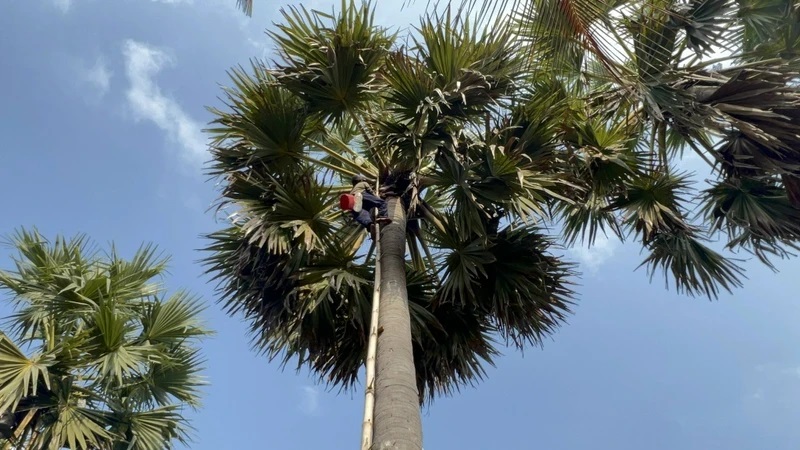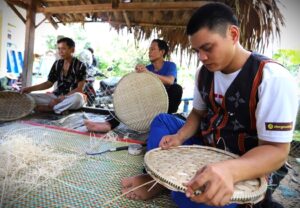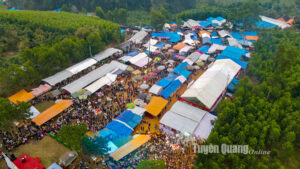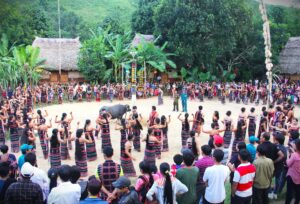Palmyra Palm prosperity: flourishing in Seven Mountains (An Giang)
Despite the harsh weather conditions of the Bay Nui (Seven Mountains) region, the palmyra palm stands tall, blooming and bearing fruit amidst the dry season of the south. From a wild plant, the “sweet nectar” of the palmyra palm is now exploited for refreshing drinks and sugar production. It has become an economic lifeline for thousands of households in the Seven Mountains region, helping them achieve stable incomes, escape poverty, and thrive.

From a wild tree, the palmyra palm has become an economic tree to escape poverty for the Khmer people in the Seven Mountains region, An Giang. (Photo: Bui Quoc Dung)
The palmyra palm, locally known as “Th’not” in the Khmer language, refers to a type of palm tree resembling a coconut tree but with thorns and fan-shaped leaves. Since the economic benefits of the palmyra palm emerged, residents of the Seven Mountains region in Tri Ton District and Tinh Bien Town, An Giang province, have started planting it along the levees of rice fields in highland areas (terraced fields near the foothills, including terraced rice fields).
The challenging job of the kind-hearted
Teacher Chau Moni Soc Kha, Principal of O Lam Secondary School in O Lam Commune, Tri Ton District, who has studied and understands the land and culture of the Khmer people in the Seven Mountains, says that those who climb the palm tree to collect the “nectar” from its flowers must be sober and kind-hearted.
“Those who climb the trees must absolutely refrain from drinking alcohol. Being kind-hearted here is to be taken both literally and figuratively. They must taste the “nectar” of the flowers every morning when they climb up to check for freshness and sweetness. If their digestion is not good, they cannot climb the tree. And when they bring down the collected palmyra palm water, if someone asks for it or needs help, they must be willing to give assistance,” explained Teacher Chau Moni Soc Kha.
Teacher Soc Kha led me to a row of palmyra palm trees next to an ancient Khmer temple, pointing to a tall bamboo pole tied firmly from the base to the top of the palm tree. He explained that it is called a “bridge tree,” like a creative form of a bamboo ladder, using bamboo joints and branches as steps to climb the palmyra palm tree more easily. “This bridge tree is very important, affecting the lives of those who climb the palmyra palm to collect the nectar.” Before climbing, the workers must thoroughly check the bridge tree, ensuring its firmness and safety. If it’s loose, they must carefully resecure it with ropes. That’s also why those climbing the palmyra palm tree must always be kind to everyone around them, avoiding causing resentment or grudges for fear of retaliation,” said Teacher Soc Kha.
Following Chau Qui Chat from Tan Loi Commune, Tinh Bien Town, into the fields when the morning dew still wet the trunk of the palmyra palm tree, in the dim light of dawn, Chau Qui Chat pointed to the rows of palmyra palm trees lined along the levee, closely packed together in a straight line. He said his family didn’t have much farmland, so he had to rent over 100 palmyra palm trees from others to exploit the “nectar” year-round. These palmyra palm trees are all about 20-25 years old and about 15m tall.
“I climb about 40 to 50 trees a day,” Chau Qui Chat said before disappearing up the tree to begin the day’s work. The tools of the palmyra palm climber consist only of a knife and plastic bottles hanging loosely around them. To harvest the “nectar,” the workers use the knife to cut the top of the palm flower, then use a bamboo stick with a tied rope to press the flower’s stem. Due to this pressure, by nightfall, the palm nectar flows into bamboo tubes or pre-prepared plastic bottles placed at the top of the flower. The next morning, the workers climb up again to collect the tubes, filled fragrant and delicious nectar.
With closely spaced palmyra palm trees, Chau Qui Chat uses a bamboo pole to bridge between two trees, avoiding the need to climb down and up again and risk falling. The bamboo bridge consists of a large bamboo pole as a walkway and another pole as a handrail to ensure safety. After two hours, as the sun rises above the trees, Chau Qui Chat completed harvesting the “nectar” from over 20 palmyra palm trees. At this time, his wife is also present under the tree waiting to receive her husband’s “spoils of war.”
Fresh palmyra palm water is sold to beverage stalls for around 10,000 dong per litre, while the rest is sold to establishments for processing into palmyra palm sugar. “The work is tough and dangerous, but I earn 300,000-400,000 dong every day. The peak season for palmyra palm harvesting is during the dry, scorching season when the nectar reserves are highest. I work for about five months a year, from the beginning of the 12th lunar month until the fifth lunar month of the following year. When the rainy season comes, I take a break because climbing trees is dangerous, and the nectar reserves are not high,” Chau Qui Chat shared.
The Seven Mountains specialty
In addition to harvesting nectar for beverages, the palmyra palm also bears a unique fruit, resembling a small coconut, which are green when young and purple when ripe. Splitting the fruit reveals the firm and juicy flesh inside, which can be combined with fresh palmyra palm water to make a delicious and refreshing drink, providing relief from the 38°C heat.
At this time, along the routes from National Highway 91, from Chau Doc City to Tinh Bien Town, or from Provincial Road 948 from Tinh Bien Town to Tri Ton District, both sides of the road are lined with beverage stalls offering products made from the palmyra palm. Fresh palmyra palm water is bottled in plastic bottles ranging from 500ml to 1,500ml, while the fruits are displayed along the roadside to attract customers. Tourist buses and pilgrims to Cam Mountain constantly stop by roadside stalls for tourists to enjoy the signature specialty of the Seven Mountains region.
Among the pilgrims, Doan Van Vang and his wife Dinh Thi Thuy Lieu enjoyed two glasses of fresh palmyra palm water at a stall. He shared, “Every time we pass by here, I have to enjoy this delicious ‘nectar.’ In the scorching sun, drinking cold palmyra palm water and enjoying fresh palmyra palm fruit is a wonderful way to cool down.”
Located in Tinh Bien Town, which has the most palmyra palm trees in the region, An Phu Ward’s traditional sugar-producing village employs about 800 workers, producing eight tons of finished sugar every day. Along the roads, alleys, and communal areas in Phu Tam Hamlet, An Phu Ward, these days are filled with the bustling work atmosphere of the people. The stoves are always red with fire, and the sweet aroma of palm sugar wafts through the air. Khmer women deftly stir the palm nectar to ensure uniformity and cook it to make thick, golden sugar, then pour it into round moulds, waiting a few minutes to produce finished sugar loaves. All these processes are done manually and entirely using natural palm nectar, without the use of any additives or preservatives. Therefore, the palmyra palm sugar of this village is certified as an organic agricultural product by NHO-QSCERT, a global certification organisation present in over 30 countries.
Though a local specialty, products from the palmyra palm have expanded beyond the village boundaries and reached as far as Europe. Among them, products like traditional palmyra palm honey, powdered palmyra palm honey, and grainy palmyra palm honey from Palmania Joint Stock Company, headquartered in Tri Ton Town, Tri Ton District, An Giang Province, are researched, produced, and exported.
Chau Ngoc Diu, the CEO of Palmania Joint Stock Company, revealed that in order to elevate the value of palmyra palm products, the company has been participating in the Great Taste Awards competition held in the United Kingdom since 2019, achieving two stars. In early 2020, Palmania won first prize in the Entrepreneurial Creative Ideas competition in An Giang Province. Palmania’s palmyra palm honey was evaluated and classified as a four-star OCOP product by the People’s Committee of An Giang Province for the 2019-2020 period.
Bui Quoc Dung – Translated by NDO
NDO – en.nhadan.vn




